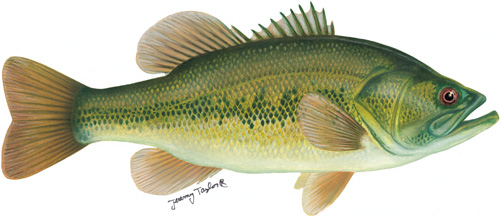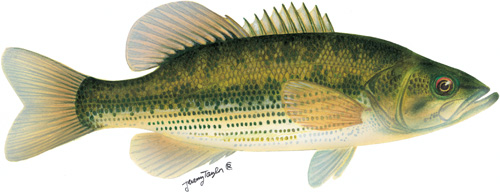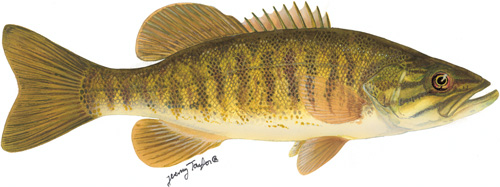Introduction
(Micropterus spp.)
Bass angling provides recreation and economic value to the state of California. For several years, California has been the center of attention for producing trophy-sized black bass. In a list of the top 25 largest largemouth bass caught in the U.S., 21 of the bass are from California waters. Nationwide attention to California 's largemouth bass fisheries began with the success of Florida largemouth bass introductions. Numerous catches of largemouth bass over 10 pounds were reported following the introductions and in 1972, the first largemouth bass over 20 pounds from California was caught at Lake Miramar. In addition to trophy-sized largemouth bass, the introduction of Alabama spotted bass in 1976 and subsequent introductions to other California waters has produced trophy-sized, and state and world record catches from California waters.
Identification
 Largemouth bass, Micropterus salmoides, were first introduced into California from Quincy, Illinois, into Lake Cuyamaca ( San Diego County ) in 1891, and are now found throughout California. Two subspecies are recognized, the northern subspecies, M. s. salmoides, and the Florida subspecies, M. s. floridanus. The first introduction of Florida largemouth bass was made in 1959 into southern California. The value of Florida largemouth bass has been demonstrated by increased catches of trophy-sized fish and nationwide public attention. Many bass greater than 10 pounds have been caught from California waters including a 21 pound 12 ounce bass caught from Castaic Lake, Los Angeles County, in 1991.
Largemouth bass, Micropterus salmoides, were first introduced into California from Quincy, Illinois, into Lake Cuyamaca ( San Diego County ) in 1891, and are now found throughout California. Two subspecies are recognized, the northern subspecies, M. s. salmoides, and the Florida subspecies, M. s. floridanus. The first introduction of Florida largemouth bass was made in 1959 into southern California. The value of Florida largemouth bass has been demonstrated by increased catches of trophy-sized fish and nationwide public attention. Many bass greater than 10 pounds have been caught from California waters including a 21 pound 12 ounce bass caught from Castaic Lake, Los Angeles County, in 1991.
 Spotted bass, Micropterus punctulatus, are divided into three separate subspecies but only the northern spotted bass, M. p. punctulatus, called Kentucky bass, and Alabama spotted bass, M. p. henshalli have been introduced into California. Although spotted bass are colored similar to largemouth bass, they can be easily distinguished by a smaller mouth and the fact that the first and second dorsal fins are connected. A tooth patch is located on the tongue of the spotted bass and can be felt when you run the tip of your finger over it. However, a portion of largemouth bass also posses the tooth patch. The Alabama spotted bass was introduced to the state in 1974. Subsequently, angler catches of Alabama spotted bass over six pounds from many waters have been verified by CDFW biologists including one that weighed 10 pounds 4 ounces, caught at Pine Flat Lake in 2001.
Spotted bass, Micropterus punctulatus, are divided into three separate subspecies but only the northern spotted bass, M. p. punctulatus, called Kentucky bass, and Alabama spotted bass, M. p. henshalli have been introduced into California. Although spotted bass are colored similar to largemouth bass, they can be easily distinguished by a smaller mouth and the fact that the first and second dorsal fins are connected. A tooth patch is located on the tongue of the spotted bass and can be felt when you run the tip of your finger over it. However, a portion of largemouth bass also posses the tooth patch. The Alabama spotted bass was introduced to the state in 1974. Subsequently, angler catches of Alabama spotted bass over six pounds from many waters have been verified by CDFW biologists including one that weighed 10 pounds 4 ounces, caught at Pine Flat Lake in 2001.
 Smallmouth bass, Micropterus dolomieu, were first introduced into California in the Napa River in 1874 from Lake Champlain, New York. Historical records indicate that anglers "fished out" the first plant and the introduction was considered unsuccessful. An introduction a few years later into Crystal Springs Reservoir, a water supply reservoir south of the city of San Francisco, was successful and provided an abundant source of smallmouth bass for additional stockings throughout the state. Most trophy-sized smallmouth bass from California have been caught in northern California waters. The California state record smallmouth bass is 9 lbs 13 oz and was caught from Pardee Reservoir in 2007.
Smallmouth bass, Micropterus dolomieu, were first introduced into California in the Napa River in 1874 from Lake Champlain, New York. Historical records indicate that anglers "fished out" the first plant and the introduction was considered unsuccessful. An introduction a few years later into Crystal Springs Reservoir, a water supply reservoir south of the city of San Francisco, was successful and provided an abundant source of smallmouth bass for additional stockings throughout the state. Most trophy-sized smallmouth bass from California have been caught in northern California waters. The California state record smallmouth bass is 9 lbs 13 oz and was caught from Pardee Reservoir in 2007.
Trophy Black Bass Certificate Program
Trophy Black Bass Program was adopted by the California Fish and Game Commission in February, 1993 under the Black Bass Conservation and management Act of 1980.
The purpose of the Program is to provide a reasonable opportunity for an angler to catch a trophy-sized black bass at designated waters. As part of the Trophy Black Bass Program, CDFW maintains records of anglers who catch a trophy size bass and submit a recognition application form to CDFW.
Verified catches are entered into CDFW databases and provide information on trophy fish catches to managers. Anglers will receive a frameable certificate documenting their catch and if the fish is released back to the water, an attractive California Trophy Black Bass Program Catch and Release hat / lapel pin.
Program Policy
In the Trophy Black Bass Program policy, trophy-sized black bass are recognized by the following minimum weight standards:
- Largemouth Bass Micropterus salmoides - 10 lb
- Smallmouth Bass Micropterus dolomieu - 6 lb
- Spotted Bass Micropterus punctulatus - 6 lb
- Alabama Bass Micropterus henshalli - 6 lb
As part of the program, the Department is charged to:
- Identify and submit to the Commission certain waters within the state to be designated as trophy-sized black bass waters based on the following criteria:
- Angler access:
- Open for public angling with unrestricted access, or
- Open for public angling with controlled access consistent with Commission policy.
- Historically or biologically demonstrated the capability of producing, with appropriate angling regulations or other fishery management actions, catch by anglers in most years of fish meeting the above trophy-sized black bass standards.
- Manage at least one water in each of the Department's six management regions as a Trophy Black Bass Water.
- Develop a management plan for each designated water. The plan shall include a description and evaluation of the fishery, an assessment of environmental factors conducive to or limiting trophy black bass management, recommendations for management actions needed to increase abundance of trophy black bass, and an assessment of personnel and fiscal resources needed to carryout the intent of the program.
- Establish a Trophy Black Bass Recognition Program. In February 1994, the Commission designated Trinity, Oroville, Clear, Isabella, and Castaic lakes as trophy black bass waters. Trophy black bass management plans were developed for these waters as part of the program.